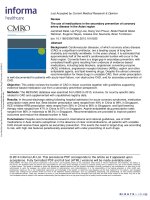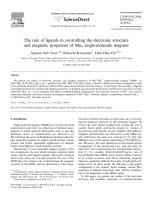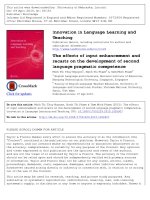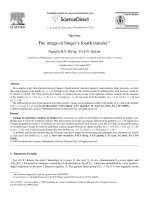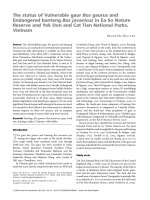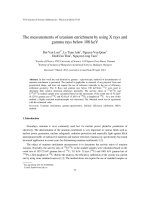DSpace at VNU: The role of carriers in properties and performance of Pt-CuO nanocatalysts in low temperature oxidation of CO and p-xylene
Bạn đang xem bản rút gọn của tài liệu. Xem và tải ngay bản đầy đủ của tài liệu tại đây (1.92 MB, 10 trang )
Home
Search
Collections
Journals
About
Contact us
My IOPscience
The role of carriers in properties and performance of Pt-CuO nanocatalysts in low temperature
oxidation of CO and p-xylene
This content has been downloaded from IOPscience. Please scroll down to see the full text.
2015 Adv. Nat. Sci: Nanosci. Nanotechnol. 6 015011
( />View the table of contents for this issue, or go to the journal homepage for more
Download details:
IP Address: 128.114.34.22
This content was downloaded on 10/02/2015 at 18:34
Please note that terms and conditions apply.
|
Vietnam Academy of Science and Technology
Advances in Natural Sciences: Nanoscience and Nanotechnology
Adv. Nat. Sci.: Nanosci. Nanotechnol. 6 (2015) 015011 (9pp)
doi:10.1088/2043-6262/6/1/015011
The role of carriers in properties and
performance of Pt-CuO nanocatalysts in low
temperature oxidation of CO and p-xylene
Cam Loc Luu1, Tri Nguyen2, Tien Cuong Hoang1, Minh Nam Hoang2 and
Cam Anh Ha2
1
Institute of Chemical Technology, Vietnam Academy of Science and Technology, 01 Mac Dinh Chi
Street, Ho Chi Minh City, Vietnam
2
Ho Chi Minh City University of Technology, 268 Ly Thuong Kiet, District 10, Ho Chi Minh City,
Vietnam
E-mail:
Received 2 November 2014
Accepted for publication 26 November 2014
Published 31 December 2014
Abstract
In this study four optimal catalysts on the basis of Pt–CuO supported on γ-Al2O3, TiO2, CeO2
and γ-Al2O3 + CeO2 have been prepared and studied. Characterizations of the catalysts have been
carried out by methods of N2 adsorption, x-ray diffraction (XRD), field emission scanning
electron microscopy (FE-SEM), transmission electron microscopy (TEM) and temperatureprogrammed-reduction (TPR). The activity of these catalysts for deep oxidation of CO, p-xylene
and their mixture was assessed at temperature range 75−300 °C. The results showed that the
presence of CO in a mixture with p-xylene has a beneficial effect on the rate of p-xylene
conversion; meanwhile the presence of p-xylene shows the inhibition on CO oxidation. In the
reactions of the mixture, oxidation of CO and p-xylene occurred simultaneously on PtCuO
catalyst supported on γ-Al2O3, TiO2, CeO2 carriers, but on catalyst PtCu/CeAl the oxidation of
p-xylene can proceed only when CO is consumed entirely. Addition of 1.1 to 3.2% mol steam
into the gas mixture exhibits no effect on the conversion of CO; meanwhile, it shows the limited
effect on oxidation rate of p-xylene on hydrophobic catalysts (PtCu/Ce, PtCu/CeAl and PtCu/
Ti), but strong inhibition on hydrophilic catalyst (PtCu/Al). However, this negative effect of
water was reversible.
Keywords: low temperature deep oxidation, Pt-CuO, CO, p-xylene, carriers
Mathematics Subject Classification: 5.06
1. Introduction
In general, precious metal catalyst is more advantageous
for purification of mixtures of gases containing aromatic
compounds and does not contain catalyst poisons (such as
sulfur compounds), thanks to the reaction requiring lower
temperatures [1]. Metal oxides are an alternative to noble
metals as catalysts for total oxidation. For some applications,
the higher overall loading of metal oxides in the catalysts
makes them more resistant to poisoning than noble metals,
while precious metal catalysts with a limited number of active
sites could be quickly poisoned by small quantities of poisons
[2]. Promotion of Al, Cr, Cu, Mn and Co catalysts by Pt has
improved their activity for CO oxidation and resistance to
SO2 poisoning [3]. The highest activity in oxidation of CuO/
Catalytic oxidation is considered as one of the effective and
economical ways of removal of impurities in industrial gases
emission to meet environmental standards. Carbon monoxide
and aromatic hydrocarbons such as xylene are prominent
environmental pollutants, therefore, to look for effective
catalysts, enabling one to oxidize CO and volatile organic
compound (VOC) at low temperatures, is an important task
for researchers in the fields of chemistry and chemical technology. The advantage of low temperature oxidation is to
reduce fuel consumption for conversion of large volumes of
polluted air.
2043-6262/15/015011+09$33.00
1
© 2015 Vietnam Academy of Science & Technology
Adv. Nat. Sci.: Nanosci. Nanotechnol. 6 (2015) 015011
C L Luu et al
CeO2 catalysts modified with Pt, is explained by the strong
link between the Pt with CuO/CeO2. Meanwhile, modification of CuO/CeO2 catalysts by Pd or Rh led to reduced catalysts activity in selective oxidation of CO, due to high
activity of additives in the oxidation of H2 [4]. Meanwhile,
the role of metal oxides is to diminish the CO inhibition,
which is a typical characteristic of reaction at low temperatures on platinum catalysts [5].
Thanks to outstanding properties such as high porosity
and large specific surface, fairly uniform structure and high
thermostable, γ-Al2O3 is widely used as a carrier for the
catalyst. In our previous studies [6–9] the optimal compositions of metal oxide catalysts for complete oxidation of CO
and p-xylene have been determined as follows: 10 wt.% CuO/
γ-Al2O3, 7.5 wt.% CuO/CeO2, 12.5 w.% CuO/TiO2
(P25Degusa), and 10 wt.% CuO/20 wt.% CeO2 + γ-Al2O3
(Cu/CeAl). These samples have been found to be the most
active and stable for the complete oxidation of CO, p-xylene
and their mixture. In the study [10], the optimal concentration
of Pt for catalysts mentioned above of 0.1 wt.% has been
determined.
As follows from previous investigation, the CO oxidation
over the CuO/Al2O3, CuCr/Al2O3 [6] and Pt/Al2O3 [11]
catalysts at low temperature was inhibited by steam. This may
be due to the hydrophilic property of alumina. Reasonably,
hydrophobic catalysts can avoid such a problem. Furthermore, as is known, organic compounds are better adsorbed on
a hydrophobic surface than on a hydrophilic one. Therefore,
hydrophobic carriers such as CeO2 and TiO2 are also studied
to be used for mixed catalysts in the low temperature oxidation of CO and VOC in this investigation.
Cu(NO3)2.3H2O, H2PtCl6 complex and urea in a minimum
volume of de-ionized water. After drying in room termperature for 24 h, at 80 °C for 2 h, at 100 °C for 2 h and at 110 °C
for 2 h, all the samples were treated at 600 °C for 4 h in an
air flow.
Brunauer–Emmett–Teller (BET) specific surface area of
the obtained catalysts was determined from N2 adsorption
isotherms at 77 K on a Quantachrome NovaWin machine.
Phase composition of catalysts was characterized by x-ray
diffraction (XRD) method on the apparatus, Shimadzu x-ray
diffractometer XD-5A. Characteristics of reduction were
investigated by method of temperature-programmed-reduction (TPR) on the apparatus, Chembet 3000, as described in
[7]. The morphology of the synthesized catalysts was
obtained using field emission scanning electron microscopy
(SEM, JEOL 7401) and transmission electron microscopy
(TEM, JEOL 1400).
Before running the reaction, the catalysts were activated
for 2 h at 300 °C in an air flow with velocity of 12 L h−1.
Activity of the catalysts in deep oxidation of CO, p-xylene
and their mixture was studied in a microflow reactor at the
temperature range 75–300 °C, concentrations of O2, CO and
p-xylene in the stream were 10.5, 0.5 and 0.34 mol%,
respectively, volume velocity of stream was 12 L h−1, catalyst
weight was 0.2 g. Reaction mixtures were analyzed on a gas
chromatograph of agilent technologies 6890 plus with a
thermal conductivity detector (TCD), capillary column HPPLOT MoleSieve 5A (30 m length, 0.32 mm outer diameter,
0.25 μm thickness) and an FID detector, capillary column DB
624 (30 m length, 0.32 mm outer diameter, 0.25 μm
thickness).
2. Experimental
3. Results and discussion
In the study, 4 following catalysts with the optimal composition: 0.1 w% Pt + 10 wt.% CuO/γ-Al2O3 (PtCu/Al), 0.1 w%
Pt + 10 wt.% CuO/(20 wt.% CeO2 + 69.9 wt.% Al2O3) (PtCu/
CeAl), 0.1 wt% Pt + 7.5 wt.% CuO/CeO2 (PtCu/Ce), and
0.1 wt.% Pt + 12.5 wt.% CuO/TiO2 (Degusa P25) (PtCu/Ti)
have been prepared. The catalysts PtCu/Al, PtCu/CeAl were
synthesized by sequential impregnations followed by the
procedure decribed in our previous work [10]: firstly with an
aqueous solution of Cu(NO3)2.3H2O, Ce(NO3)3.6H2O, followed by the second impregnation with a solution of H2PtCl6
in distilled deionized water. The impregnated samples were
left overnight in air, then dried and calcined for 2 h at 300 °C.
A catalyst PtCu/Ce was prepared by the urea nitrates combustion method, following the procedure described by
Matralis et al [12]: Ce(NO3)3.6H2O, Cu(NO3)2.3H2O,
H2PtCl6 complex, and urea (CO(NH2)2) were mixed in a
minimum volume of distilled water in order to obtain a
transparent solution. The optimum molar ratios of urea/nitrate
is 4.17 [13]. The mixed solution was left overnight in the air,
then dried at 80 °C, 100 °C, 110 °C for 2 h at every temperature and calcined for 4 h at 600 °C in an air flow. A
catalyst PtCu/Ti was prepared by co-impregnation method of
TiO2−P25 Degusa support with aqueous solutions, containing
3.1. Physico-chemical characteristics of catalysts
From the field emission scanning electron microscopy (FESEM) imagine (figure 1) it follows that, there are the particles
of catalyst in the form of the ball shape existed on the surface
of catalysts. On TEM images (figure 2) the dispersed particles
Pt in size of 1−3 nm and CuO clusters with dimension of a
few tens nm on surface of the catalysts could be observed.
Crystal size of CuO calculated by XRD pattern (figure 3) at
the angle 2 θ = 35o of PtCu/Al and PtCu/Ti was determined to
be 18.8 and 26.2 nm, respectively. The agglomeration of CuO
particles into large clusters, as observed in TEM image
(figure 2), covering the surface of carriers led to significant
reduction in the specific surface area of catalyst. The specific
surface area of the carriers of 252, 103 and 45 m2 g−1, corresponding to γ-Al2O3, CeO2, and TiO2-P25 were determined, while these values for PtCu/Al, PtCu/CeAl, PtCu/Ce,
PtCu/Ti catalysts are 95.9, 80.1, 14.8, and 16.2 m2 g−1,
respectively. Besides, for PtCu/Ti catalyst, after heat treatment at 600 °C, content of the rutile phase in TiO2, calculated
according to the intensity of characteristic peak of rutile phase
at the angle 2 θ = 27.5° by formula shown in [14], was 93.8%,
so TiO2 in the form of large spherical particles (approximately
2
Adv. Nat. Sci.: Nanosci. Nanotechnol. 6 (2015) 015011
C L Luu et al
Figure 1. FE-SEM imagine of the catalysts: (a) PtCu/Al, (b) PtCu/CeAl, (c) PtCu/Ce and (d) PtCu/Ti.
Figure 2. TEM imagine of the catalysts: (a) PtCu/Al, b) PtCu/CeAl, (c) PtCu/Ce and (d) PtCu/Ti.
50–100 nm) can be observed in figure 2(d). It is the second
reason leading to low specific surface area of the catalyst
PtCu/Ti.
As seen from figure 2, dimension of Pt particles and CuO
clusters on PtCu/Ce is smallest and on PtCu/Ti is biggest. On
PtCu/Ce sample the values of agglomerates size of Pt and
3
Adv. Nat. Sci.: Nanosci. Nanotechnol. 6 (2015) 015011
C L Luu et al
Figure 4. TPR profiles of catalysts: (1) PtCu/Al; (2) PtCu/CeAl; (3)
PtCu/Ce; (4) PtCu/Ti.
and 54.3°) and characteristic peaks of CuO and Pt with low
intensity.
XRD analysis results showed that γ-Al2O3 exists in the
catalysts in the amorphous state, and that on TEM image
(figure 2(a)) of PtCu/Al very small porous particles of Al2O3
can be observed. CeO2 in PtCu/Ce and PtCu/CeAl samples
exists in the crystalline state with the crystallite size of
11.8 nm and 7.1 nm, respectively. The crystallite size of TiO2
in PtCu/Ti sample of 34.5 nm was determined. The order
in the intensity of the characteristic peaks of CuO
and CuO crystallite size in the catalyst Pt–CuO supported
on various carriers was observed as follows:
Al2O3 > TiO2 > (CeO2 + Al2O3) ≈ CeO2. This indicates that
CuO dispersed on CeO2 better than on Al2O3 and TiO2.
In a TPR diagram of the PtCu/Al sample (figure 4, line
1), a peak at Tmax = 274 °C and a shoulder at about 400 °C can
be observed. Dow et al [16] reported that for the CuO/Al2O3
catalyst, a peak with a maximum at 210 °C is created due to
the reduction of the highly dispersed copper oxide species and
the reduction peak with tmax > 250 °C has been ascribed to the
reduction of bulk-like CuO phases. In our previous paper [17]
the TPR profile of Cu/Al sample is characterized by two main
reduction peaks: a peak at Tmax = 375 °C was attributed to the
reduction of buck CuO phase and another peak with lower
intensity at Tmax = 300 °C of small cluster CuO. According to
Lenarda et al [18], CuO buck shows one reduction peak at
400 °C due to complete reduction of Cu2+ to Cu°. Subramanian [19] reported that the hydrogen reduction process of
Pt/Al2O3 system takes place at the temperature range of 300
−500 °C, but Castro et al [20] points out that on TPR diagram
of Pt/Al2O3, a reduction peak at 240 °C due to reduction of
platinum can be observed. Therefore, it can be suggested that
the peak at Tmax = 274 °C in the TPR diagram of the PtCu/Al
sample characterizes the reduction of small cluster CuO and a
Figure 3. XRD patterns of catalysts: (1) PtCu/Al; (2) PtCu/CeAl; (3)
PtCu/Ce; (4) PtCu/Ti. (Pt–Pt; Cu–CuO; Al-Al2O3; CuAl–CuAl2O4;
Ce–CeO2; Ti(R)–TiO2 rutile; Ti(A)–TiO2 anatase).
CuO are 1 nm and 10 nm, respectively, while on PtCu/Ti
these values are 1–3 nm and 40−60 nm, respectively.
As seen on XRD pattern of PtCu/Al catalyst (figure 3,
line 1) the CuO phase is characterized by the most intensive
peaks, the characteristic peaks of γ-Al2O3 and of aluminate
CuAl2O4 are very weak; at the same time the characteristic
peaks of Pt with low intensity can be observed. XRD pattern
(line 3) of catalyst PtCu/Ce is quite similar to that of PtCu/
CeAl (line 2), characterized by intensive characteristic peaks
of the cubic fluorite structured CeO2 at 2 θ = 28.6°, 33°, 47.4°,
56.3°, 59o, 69.4°, 76,7o, 79° [15] and very weak peaks,
characteristic of CuO, γ-Al2O3, and Pt. However, the intensity
of characteristic peaks of CeO2 in PtCu/CeAl catalyst has
been observed to be significantly weaker compared to those in
the PtCu/Ce sample. It indicated that the interaction of CeO2
with Al2O3 made cerium oxide to be crystallized in smaller
agglomerate. Additionally, the TPR profiles in figure 4 are
consistent with these observations because the reduction peak
around 687 °C for the PtCu/Ce catalyst, which has been
assigned to bulk CeO2, is absent in the profile of the PtCu/
CeAl catalyst. Furthermore, the XRD patterns of the two
samples containing CeO2 (PtCu/CeAl and PtCu/Ce) showed
very weak CuO reflections, indicating that the copper oxide
phase exists in a highly divided or amorphous state on the
surface of ceria, or the formation of solid solution, or a
combination of these two phenomena [12]. XRD results of the
catalysts PtCu/Ti (figure 3, line 4) showed the intensive
characteristic peaks of TiO2 in rutile phase (2 θ = 27.5°, 36.1°,
4
Adv. Nat. Sci.: Nanosci. Nanotechnol. 6 (2015) 015011
C L Luu et al
Table 1. Characteristics of the obtained catalysts. The values of surface specific area (SBET), crystal size of TiO2 rutile phase at the angle
XRD
XRD
2 θ = 27.5°, CeO2 at 2 θ = 28.6° d Carrier
and CuO at 2 θ = 35° dCuO
, and maximum reduction temperature (Tmax), extent of
reduction (KRed).
(
)
(
)
Catalysts
CuO content (%)
SBET (m2 g−1)
XRD
(nm)
d Carrier
XRD
(nm)
d CuO
Tmax (°C)
Kred (%)
PtCu/Al
PtCu/CeAl
PtCu/Ce
PtCu/Ti
10
10
95.9
80.1
14.8
16.2
—
7.1 (CeO2)
11.8 (CeO2)
34.5 (TiO2-R)
18.8
n.d
n.d
26.2
274; 400
255
184; 214; 545; 687
233
36.7
45.8
32.2
17.2
7.5
12.5
n.d: not detected.
shoulder at about 400 °C characterizes the reduction of nonassociated buck CuO on the surface of catalyst.
The TPR diagram of catalyst PtCu/CeAl shows only one
peak at 255 °C, which is assigned to the reduction of small
clusters CuO. Our group previously reported that there were
two reduction peaks presented in Cu/CeAl catalyst: the peaks
at Tmax = 276 °C and 321 °C were attributed to the reduction
of small clusters copper oxide and of larger CuO particles,
respectively [8]. In the case of this study, the appearance of
only one reduction peak at lower temperature (255 °C) on
TPR profile of PtCu/CeAl can be explained by the formation
of small CuO particles on the surface of alumina when catalyst was promoted by a small amount of Pt. The maximum
reduction temperature of CuO on the Pt-promoted (PtCu/Al
and PtCu/CeAl) markedly lower than that on the non-promoted sample Cu/Al, suggesting that the redox properties of
CuO and the morphologies of catalysts are significantly
affected by Pt as well as CeO2. Furthermore, it can be
observed from table 1 that the reduction extent of CuO
increases from 36.7 to 45.8% when the Al2O3 support is
modified with ceria addition.
The TPR diagram (figure 4, line 3) for the PtCu/Ce
catalyst shows a main reduction peak at 214 °C, two small
peaks at 545 °C and 687 °C and a small shoulder at about
184 °C. Avgouropoulos et al [12] observed three reduction
peaks in the TPR profiles of CuO–CeO2 catalysts prepared by
the urea-nitrates combustion methods; one at about 170 °C
attributed to the reduction of highly dispersed copper oxide
strongly interacting with the ceria surface, and the peaks at
higher temperature (about 220 °C and 255 °C) attributed to
the reduction of larger CuO particles less associated with
ceria. According to Wu et al [21] a peak at about 800 °C in
the TPR profile of Cu1Ce4 is attributed to the reduction of
bulk oxygen atoms in CeO2. In another publication [22], Wu
reported that there were four overlapping reduction peaks
presented in CuO–CeO2 catalyst: the peaks in the range of
134–140 °C and 183–204 °C were attributed to the reduction
of noncrystalline CuO strongly interacting with CeO2 and of
larger CuO particles less associated with CeO2, respectively.
The peaks in the range of 215–219 °C and 248 °C represented
the reduction of bulk copper oxide associated with CeO2 to
some extent and the reduction of pure bulk copper oxide,
respectively. Therefore, it can be suggested that the peak at
214 °C on TPR diagram of the PtCu/Ce sample (figure 4, line
3) characterizes the reduction of small buck copper oxide
associated with CeO2, the peaks appearing at higher
temperature (about 545 and 687 °C) are most probably due to
the reduction of Pt particles associated with ceria and of
CeO2, respectively [18]. The small shoulder at about 184 °C
is attributed to the reduction of highly dispersed copper oxide
strongly interacting with the ceria surface. For the PtCu/Ti
sample (curve 4 in figure 4) an intense peak at 233 °C and two
small ones, less defined, at about 275 and 415 °C can be seen.
It can be suggested that the peaks at Tmax = 233 °C and 275 °C
were attributed to the reduction of small clusters of copper
oxide strongly interacting with TiO2 and of bulk CuO weakly
associated with TiO2, respectively. The peak appearing at
415 °C are probably due to the reduction of pure bulk copper
oxide.
3.2. Catalytic performance for deep oxidation
Results of catalytic performance tests obtained over various
Pt–CuO catalysts are summarized in figure 5, where conversion of CO, p-xylene individually and in the mixture (Xi) is
plotted as a function of reaction temperature. It should be
noted that the only product detected in these experiments is
CO2. The ‘light-off’ temperatures for 50% (T50) and 100%
(T100) conversion of CO and p-xylene individually and in the
mixture of the catalysts are shown in table 2.
Conversion of CO and p-xylene increases with increasing
temperature and the conversion curves in all cases and on all
catalysts are similar to each other. Furthermore, the light-off
curves were steep for all catalysts except for CO oxidation on
PtCu/Al sample (figure 5). Compared to oxidation of single pxylene, in the case of oxidation of single CO, all catalysts
express higher activity. It has been shown in table 2 that the
light-off temperatures (at about 50% conversion) of CO is
lower than that for p-xylene from 90 to 170 °C. Complete
conversion of p-xylene on all catalysts is reached at 300 °C
and the complete oxidation of CO is achieved at around
125–275 °C. Thus, from the obtained results in table 2 it is
possible to order the catalysts on the basis of their activities
(temperatures of 50%- and 100%-conversion of carbon
monoxide and p-xylene) as follows: PtCu/CeAl ≈ PtCu/Ce >
PtCu/Ti > PtCu/Al.
Compared to Cu/Al catalyst (not shown), addition of
0.1 wt.% Pt, the temperature for 50%-conversion of CO
reduced from 225 °C down to 165 °C, and the temperature for
100%-conversion of CO reduced from 300 °C down to
275 °C. The positive effect of platinum can be explained as
follows: by weakening the interaction Cu–Al2O3 the added Pt
5
Adv. Nat. Sci.: Nanosci. Nanotechnol. 6 (2015) 015011
C L Luu et al
Figure 5. The light-off curves of CO and p-xylene individually (dashed line) and in the mixture (full lines) (Xi) for studied Pt–CuO catalysts:
(a) PtCu/Al, (b) PtCu/CeAl, (c) PtCu/Ce and (d) PtCu/Ti.
Table 2. Light-off temperatures for catalysts in oxidation of substances individually (I) and in the mixture (II).
Temperatures for 50%
Temperatures for 100%
CO
(°C)
T50
xyl
(°C)
T50
Catalysts
I
II
I
II
I
II
I
II
PtCu/Al
PtCu/CeAl
PtCu/Ce
PtCu/Ti
165
89
85
140
262
187
212
262
255
258
258
274
260
212
212
256
275
125
125
200
275
200
225
275
300
300
300
300
275
275
225
275
enables it to enhance the reducibility of catalyst (the extent of
reduction of CuO increased from 13 to 36.7% and maximum
reduction temperature decreased from 300 to 274 °C).
It is observed that two catalysts containing CeO2 (PtCu/
CeAl and PtCu/Ce) are the most active catalysts of this series,
exhibiting measurable conversion of CO at temperatures as
low as 75 °C and reaching 100% CO conversion at around
125 °C. It was found that CeO2 depressed the formation of
massive CuO, on these catalysts the copper oxide phase exists
in a highly divided or amorphous state, as indicated the XRD
pattern, reducing at low temperature. PtCu/CeAl is the only
catalyst, in which CuO exists only in the form of highly
dispersed CuO with the highest degree of reduction of this
series of catalysts. PtCu/Ce is the only the catalyst; in its TPR
diagram the reduction peak of Pt (Tmax = 545 °C) was
observed. From the EDS and EDX data (figure 6), it follows
that Cu and Pt are evenly distributed on the surface of CeO2
of the PtCu/Ce catalyst, and Pt content on the catalyst surface
CO
(°C)
T100
xyl
(°C)
T100
reaches 10.14 wt.%, significantly higher than the Pt content of
catalyst (0.1 wt.%), suggesting a strong concentration of Pt on
the catalyst surface, that should lead to the appearance of the
reduction peak of ion Pt on TPR diagram.
As follows from table 2, among the studied catalysts,
PtCu/Al exhibited the worse activity for combustion of CO,
p-xylene as well as for their mixture, compared to the rest. It
may relate to the contribution of bulk CuO and the maximum
reduction temperature of CuO on PtCu/Al being highest. Luo
et al [23] previously reported that the finely dispersed CuO is
responsible for the high catalytic activity for low-temperature
CO oxidation, while the bulk CuO contributes little to the
activity.
It follows from the presented results in table 2 that the
catalysts containing CeO2 (PtCu/CeAl and PtCu/Ce) expressed very high activity in CO oxidation; the entire oxidation of
CO could be reached at a very low temperature (125 °C),
150 degrees lower than that for the catalyst without CeO2
6
Adv. Nat. Sci.: Nanosci. Nanotechnol. 6 (2015) 015011
C L Luu et al
Figure 6. (a) EDX and (b) EDS results of the PtCu/Ce catalyst.
(PtCu/Al). However, for p-xylene oxidation, CeO2 did not
express its effect clearly. Also, the results obtained by authors
[24] indicated that CeO2 played a promoting role in CO
oxidation but displayed very little influence in oxidation of
methane, ethanol and ethyl acetate.
As can be observed from figure 5, in the presence of pxylene the conversion of CO is retarded, catalysts become
active for CO oxidation at temperatures of 150−200 °C, significantly higher than in the case of oxidation of single CO.
Figure 5 shows remarkable shift of the conversion curve of
CO towards the higher temperature region; meanwhile, for the
conversion curve of p-xylene a shift in the opposite direction,
a lower temperature region with different rates, in comparison
with the oxidation of individual components. In the mixture
with p-xylene, temperature of 50% CO conversion is around
187−262 °C (table 2), about 97−127 °C higher than that in
case of oxidation of single CO. Meanwhile, in the mixture
value of temperature of 50% conversion of p-xylene remained
nearly unchanged on PtCu/Al and about 18−46 °C lower than
in the case of oxidation of individual p-xylene.
Thus, one can notice the identical mutual influence of CO
and p-xylene on each other in oxidation of their mixtures on
the catalyst based on Pt-CuO, but this observation is considerably different from that on noble metals (Pt, Pd and Rh)
catalysts [25]. The increase of temperature of hydrocarbons
oxidation in the mixture with CO compared to absence of CO
to achieve the same conversion is a fairly common phenomenon for noble metal catalysts [25]. On Pt surfaces, CO
adsorbed stronger than hydrocarbons and ocupied almost the
whole surface of Pt, so it expressed inhibition on the oxidation of hydrocarbons [26]. Also, due to the influence of the
adsorption of hydrocarbons the temperature of CO oxidation
in the mixture to achieve the same conversion is higher than
that in the case of CO individually. In this study, the shift of
the conversion curve of p-xylene towards the lower temperature region can be explained by two reasons. The first
reason is the presence of a large amount of CuO centered on
the surface of catalysts, which should be able to increase the
adsorption of p-xylene, and the second reason is the additional heat generation from CO oxidation or the formation of
specific intermediates in the conversion of the additive substance [27]. It has been found from study of catalytic combustion of chlorobenzene on a 2 wt.% Pt/γ-Al2O3 catalyst in
binary mixtures with various hydrocarbons (toluene, benzene,
cyclohexane, cyclohexene, 1, 4-cyclohexadiene, 2-butene,
and ethene) and with carbon monoxide in [28] that, compared
to single substances oxidation, the reaction rate of combustion
of substances in a binary mixture can increased or decreased.
As can be observed from figure 5, in the oxidation of
mixture on the PtCu/Al, PtCu/Ce and PtCu/Ti the conversion
curve of CO and p-xylene is almost identical, suggesting that
processes of CO and p-xylene oxidation proceeded practically
simultaneously and the temperature of 100% conversion of
CO and p-xylene is approximately the same. This result
indicates identical adsorption properties of these reactants on
these catalysts and/or the common intermediate containing
both CO and p-xylene, was formed. Meanwhile, on PtCu/
CeAl, one can observe the p-xylene conversion reached only
44% when CO was almost completely converted. It is possible to propose a preference on catalysts PtCu/CeAl for CO
adsorption over xylene adsorption on the surface of the catalyst. In this case, xylene can be adsorbed and oxidized to a
considerable extent only after the surface has been released
from CO [25]. Nevertheless, the competitive adsorption of
p-xylene, in different extents on different catalysts, could
increase the temperature of 50% conversion (T50) of CO.
3.3. The effect of water on stability of the catalysts
As previously reported, moisture dramatically influences
VOC oxidation in most cases, especially at low temperatures.
Figure 7 shows the life test of catalysts in reaction in dry and
humid medium. The total oxidation of CO and p-xylene over
studied catalysts was carried out continuously in dry condition for more than 30 h. As can be seen from figure 7, the
conversion remains constant at ∼85% for the 30 h of the test.
This leads us to believe that these samples have a high
stability.
When steam (from 1.1 to 3.2% mol) was added at 180 °C
to the gas stream, the oxidation of CO on all catalysts was
stable and the concentration of water in the gas mixture had
no effect on the conversion of CO (figure 7(a)). Meanwhile,
adding of steam showed the different effect on activity of
various catalysts for the oxidation of p-xylene into CO2 at
267 °C. On two catalysts, containing CeO2 (PtCu/CeAl and
PtCu/Ce) the limited effect of water on oxidation rate was
obtained (figure 7(b)). The oxidation of xylene into CO2 over
7
Adv. Nat. Sci.: Nanosci. Nanotechnol. 6 (2015) 015011
C L Luu et al
Figure 7. Conversion of CO at 180 °C (a) and p-xylene into CO2 at 267 °C (b) over various Pt-CuO catalysts in the medium with and without
steam.
PtCu/Ti was slightly reduced from 85% to about 65%
(figure 7(b)) when concentration of water in the gas mixture
increased from 1.1 to 3.2% mol. This low effect of water can
be explained by the presence of hydrophobic supports. In the
case of PtCu/Al, catalyst prepared from a hydrophilic support
γ-Al2O3, xylene oxidation at 267 °C was strongly inhibited by
the presence of water (figure 7(b)). The conversion of
p-xylene into CO2 passed from 85% to 5% when the water
was added to the feed, and the higher the concentration of
steam added, the stronger the inhibition that was observed.
However, this negative effect of water was reversible, which
suggests that metallic sites were not modified by the presence
of steam. The strong influence of steam on oxidation of
p-xylene without effect on the conversion of CO on hydrophilic catalyst PtCu/Al can be explained by the preferred
adsorption of CO on Pt surface, but p-xylene on metal oxide
surfaces.
The diversity of effect of steam on oxidative activity of
precious metal catalysts was also mentioned by other authors
[29–32]. Commonly, the effect of steam depends on the
nature of reactant and of catalyst. Thus, during oxidation of
chlorinated compounds, the presence of steam retards the
conversion on Pd catalysts, while on Pt the activity is
enhanced [29]. Moreover, CO oxidation can be significantly
inhibited by the presence of water in feed stream [30].
According to Patrick Magnoux et al [31], the hydrophobicity
of the support might offer advantage for the oxidation of
various VOC in the presence of moisture. The results in [32]
indicate that activity of Pt/activated carbon for complete
oxidation of BTX is only slightly influenced by moisture
because of negligible water adsorption or condensation of
activated carbon.
4. Conclusion
In conclusion, the catalyst contained CeO2 (PtCu/Ce and
PtCu/CeAl) expressed the best activity in oxidation of CO, pxylene as well as their mixture. This catalyst is able to oxidize
completely CO and p-xylene individually at 125 °C and
300 °C, respectively, and make the same for these reactants in
their mixtures at 200−225 °C and 225−275 °C, respectively.
The presence of CO in a mixture with p-xylene has a
beneficial effect on the rate of p-xylene conversion, meanwhile presence of p-xylene shows the inhibition on CO oxidation. The temperature for 50% CO conversion has
increased from 97 to 127 °C, and the temperature for 50% pxylene conversion decreased from 5 to 46 °C.
On PtCu/Al, PtCu/Ce, PtCu/Ti catalysts the processes of
oxidation of both the reactants could proceed simultaneously,
meanwhile, on PtCu/CeAl catalyst oxidation of p-xylene can
proceed only when CO is consumed entirely; nevertheless,
the p-xylene adsorption also can reduce the intensity of CO
oxidation.
Addition of steam into the gas mixture has no effect on
the conversion of CO; meanwhile, it shows limited effect on
oxidation rate of p-xylene on hydrophobic catalysts (PtCu/Ce,
8
Adv. Nat. Sci.: Nanosci. Nanotechnol. 6 (2015) 015011
C L Luu et al
[11] Hegedus L L, Oh S H and Baron K 1977 AIChE J. 23
632
[12] Avgouropoulos G, Ioannides T and Matralis H 2005 App.
Catal. B 56 87
[13] Avgouropoulos G and Ioannides T 2003 Appl. Catal. A
244 155
[14] Spurr R A and Howard M 1957 Anal. Chem. 29 760
[15] Chen H I and Chang H Y 2005 Solid State Commun. 133 593
[16] Dow W P, Wang Y P and Huang T J 2000 Appl. Catal. A
190 25
[17] Loc L C, Cuong H T, Tri N and Thoang H S 2011 J. Experi.
Nanosci. 6 631
[18] Elisa M et al 2008 Appl. Catal. A 335 46
[19] Subramanian S 1992 Platinum Met. Rev. 36 98
[20] De Miguel S R, Baronetti G T, Castro A A and Scelza O A
1988 Appl. Catal. 45 61
[21] Yan S, Shuping W, Tongying Z, Shurong W, Baolin Z,
Jianliang C, Zhongyong Y, Shoumin Z, Weiping H and
Shihua W 2008 Catal Lett. 124 405
[22] Zheng X C, Zhang X L, Wang X Y, Wang S R and Wu S H
2005 Appl. Catal. A 295 142
[23] Luo M F, Zhong Y J, Yuan X X and Zheng X M 1997 Appl.
Catal. A 162 121
[24] Larsson P O and Andersson A 2000 Appl. Catal. B 24 175
[25] Patterson M J, Angove D E and Cant N W 2000 Appl. Catal. B
26 47
[26] Engel T and Ertl G 1979 Adv. Catal. 28 1
[27] Barresi A A and Baldi G 1992 Chem. Eng. Sci. 47 1943
[28] Van den Brink R W, Louw R and Mulder P 2000 Appl. Catal.
B 25 229
[29] van den Brink R W, Krzan M, Feijen-Jeurissen M M R,
Louw R and Mulder P 2000 Appl. Catal. B 24 255
[30] Wu J C S and Chang T Y 1998 Catal. Today 44 111
[31] Philippe D, Ludovic P, Patrick M and Michel G 2001 Surf.
Chem. Catal. Chem. 4 41
[32] Wu J C S, Lin Z A, Tsai F M and Wei J 2000 Catal. Today
63 419
PtCu/CeAl and PtCu/Ti), but strong inhibition on hydrophilic
catalyst (PtCu/Al). However, this negative effect of water was
reversible. Hence, PtCu/Ce and PtCu/CeAl showed themselves to be the most active and stable catalysts for deep
oxidation of CO, p-xylene and their mixture in humid gas.
Acknowledgments
This work was supported by the Vietnam National Foundation for Science and Technology Development (NAFOSTED)
under grand No.104.03-2012.60.
References
[1] Spivey J J 1989 Catalysis ed G C Bond and G Webb vol 8
(Cambridge: The Royal Society of Chemistry)
[2] Harrison B, Diwell A F and Hallett C 1988 Platinum Met. Rev.
32 73
[3] Osmanov M O 1986 Azerb. Khim. Zh. 4 34 (in Russian)
[4] Jung C R, Kundu A, Nam S W and Lee H-I 2007 Appl. Catal.
A 331 112
[5] Oh S H and Hoflund G B 2006 J. Phys. Chem. A 110 7609
[6] Loc L C, Cuong H T and Tri N 2009 J. Chem. 47 56 (in
Vietnamese)
[7] Loc L C, Hien N T T, Dung N K, Cuong H T and Thoang H S
2006 Adv. Nat. Sci. 7 245
[8] Loc L C, Cuong H T, Tri N and Thoang H S 2010 J. Chem.
Chem. Eng. 4 48
[9] Tri N, Loc L C, Thinh T P, Tien T Q, Cuong H T and
Nam H D 2013 J. Chem. 51 435 (in Vietnamese)
[10] Loc L C, Mai D T T, Tri N, Cuong H T, Huong B T and
Thoang H S 2010 J. Chem. 48 84 (in Vietnamese)
9




